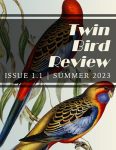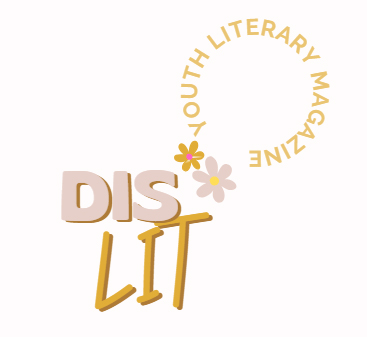New Lit on the Block :: Twin Bird Review

Seeing double can be a good thing, as Twin Bird Review can attest. This new open-access online biannual publishes poetry, creative nonfiction, art, comics, and graphic narratives. The name comes from legend, says Editor Amanda K Horn. “Sailors used to get a tattoo of a swallow after the first 5,000 nautical miles traveled, and then another after 10,000 – barn swallows to represent birds’ ability to travel very far abroad and yet still return home. These ‘twin birds’ can also be seen in the human imagination, through which we’re able to explore this world and others, ourselves, the past and the future, all without leaving home.”
Herself a writer and editor based out of New York, Horn holds an MFA in fiction from Columbia University, previously served as an editor for The Offing and The Columbia Journal, and as a fiction reader for Electric Literature’s The Commuter. She has been in the publishing industry since 2014, working in the editorial departments of publishers including Akashic, TASCHEN, and most recently as an editor for Berghahn Books, an independent academic press specializing in the humanities and social sciences.
“After almost ten years in publishing,” Horn says about the inspiration for Twin Bird Review, “working with both literary publications and books – as well as my time in the MFA program at Columbia – like many, I found myself really discouraged by the toxicity of the literary world. In starting Twin Bird Review, I am hoping to forefront joy, imagination, and vibrancy over the perfection and gatekeeping that we have come to expect in the world of publishing.
“Ethical publishing is an absolutely essential component of our mission statement. The literary world is unforgiving in almost every way an industry can be unforgiving. It’s competitive and demanding, an immense amount of work often for no pay. It requires the writer to be very vulnerable in public, and have that vulnerability rejected over and over and over again. Sometimes even perfection isn’t perfect enough. The term ‘gatekeeping’ is common, and inequality persists across race, gender, and socio-economic status. These are complicated issues that cannot easily be solved, especially not by one well-intentioned publication; however, we hope that our guiding mission statement and editorial practices might at least take some of the edge off. We want to encourage writers to be themselves, to celebrate imaginative works for the sake of imagination, and even if the work doesn’t fit into our next issue, we want to make it clear to each artist and writer that their voice, their world, matters. Essentially, we’re hoping to be the change we want to see.”
Participating in that change is a board of readers who review all the submissions, as Horn explains their process. “All submissions are initially vetted for suitability – that is to say, making sure it’s a genre/format we publish, does not include excessive violence, hate speech, or any other problematic content. Submissions are then reviewed by our readers, who provide brief feedback before final publication decisions are made. We aim to respond within twelve weeks, although sometimes it may take a bit longer since we currently have a very small staff and want to make sure that each piece is given careful consideration.
“We don’t typically provide feedback beyond briefly noting some of each piece’s strengths, partially due to high submission loads but also because we want to emphasize that assessment for publication is ultimately a subjective process that relies on many factors beyond simply the quality of writing – for example, perhaps there’s one really excellent story about a talking dog, but we have already accepted a similar piece.”
Readers of Twin Bird Review will appreciate this careful curation of works by enjoying some unique selections. “In our first issue,” Horn shares, “ghostly kittens haunt a woman during her mother’s mastectomy. A young married couple seeks to repair their deteriorating house by any means necessary. A spare bedroom contains a primal secret. A talk-show host meditates on body, mind, and soul. From shadow bodies to dinosaur tracks, carrot babies to mysterious pigeons, our inaugural issue features pieces that are dreamy, surreal, and sometimes nightmarish.”
Contributions to the first issue include fiction by D.W. Davis, Cecilia Kennedy, Norie Suzuki, Matthew Batham, Catherine Yeates, Ananda Naima González; a graphic narrative by Eva Adderley; essays by Amy Cotler, Ann Iverson; poetry by Rayne Affonso, Karla Linn Merrifield, Hibah Shabkhez, DS Maolalai, Lawrence Bridges, William Doreski, Joanna Hope Bricher, Justin Evans; and artwork by Nadia Arioli, Sarah Ehlen, Phyllis Green, Irina Tall Novikova, and Jimena Yengle.
Reflecting on the experience of bringing Twin Bird Review to life, Horn says, “The best thing about starting and maintaining a publication is also the worst thing – reviewing everyone’s submissions! It’s genuinely exciting to read the work; there’s something to admire in almost every piece we receive, and it’s an honor to be entrusted with people’s work. That said, it’s really hard to have to decline pieces – really, really hard. When we invite someone to submit again to future issues, we genuinely mean it!”
Horn is optimistic about moving forward with Twin Bird Review. “We are currently reading for our second issue, which is expected to publish in December. We’re also looking at bringing more people onboard our masthead to help expand our reach and provide more support for each issue. Our biggest long-term goal is to transition to a paying market within the next year or two, once we’re in a good position to do so.”
For contributors, Horn emphasizes, “While we’d love to review any genre of imaginative work for our next issue, we’re especially interested in comics and graphic narratives, artwork, as well as creative nonfiction.”




